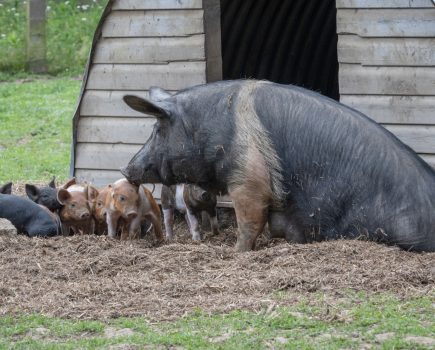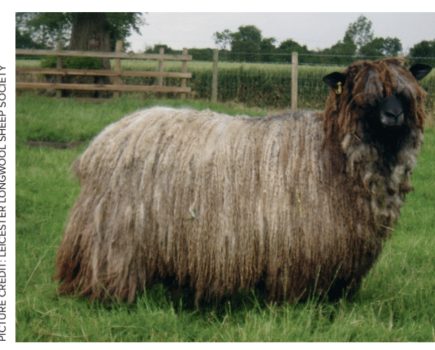Mary Castell prepares for the lambing season
Preparations for lambing become serious during the final two months of the pregnancy, since 85% of the lamb’s growth takes place during this period, and clearly, the diet of the ewe has to reflect the increased demands put upon her. This is especially important in the final two weeks, when the developing lamb pushes up against her rumen, thereby reducing its volume and restricting the intake of bulky feeds, such as hay. To avoid the ewes jostling up against one another at the feed trough, 450mm should be allowed for a 70kg ewe at the trough, and 150mm at the hay rack. Horned ewes require additional space. In weeks six and five pre- lambing, each ewe is given a daily ration of 0.5kg of concentrate, divided into a morning and an evening feed. During weeks four and three pre-lambing, the daily ration is increased to 0.75kg, again given in two daily feeds. In the final fortnight the daily ration is increased to 0.9kg. It’s important to divide the daily ration into two even feeds to avoid a high level building up in the stomach, as there is some impairment in the digestion of a concentrate feed for two to three hours following the feed. Another feeding system, ‘flat rate’ feeding, is useful for breeders who haven’t raddled their rams and, therefore, can’t know the dates on which their ewes are likely to lamb. In this system, the same total quantity of feed is given, but is divided into two equal daily portions over the six weeks pre-lambing. This system requires an introductory week, during which the concentrate feed is built up gradually to the required amount. A ewe that lambs early will have received almost all the required quantity of feed, and one that lambs late is able to rely on the good condition she has achieved during the previous weeks of feeding. Whichever feeding system is used, it’s advisable to separate first-time lambers from the other ewes, to make sure that they’re not pushed away from the trough by the older sheep and deprived of their fair share of feed. The aim of pre-lambing feeding is for lowland sheep to have achieved a condition score of 2.5 – 3.0 by the time they come to lamb, and hill ewes a score of 2.0 – 2.5.A convenient time to make an interim check on the condition of the sheep is when the ewes are given their vaccination against clustered diseases, which is normally between four and six weeks before the expected lambing date. In addition, the ewes are crutched – dirty and long wool is clipped away from the back end to avoid the lamb getting dirty during birth, and long wool is clipped away from the udder, making it easier for the lambs to find their mother’s teats.This is also a good time to erect lambing pens. If these are inside, the floor must be disinfected first and the hurdles cleaned. Sufficient buckets for the number of pens are collected together and given a good wash. The heat lamp is dusted down and attached to a stand, which can be moved from pen to pen when needed to warm poorly lambs. When the usual metal hurdles are used to make lambing pens, it’s advisable to have lengths of wire netting available to fix around the bottom of the pen to stop adventurous lambs climbing out. They may go walk-about among strange ewes who are likely to give the intruder a strong butt. Many smallholders keep Rare Breeds, and the more primitive of these produce exceptionally small and agile off-spring which regard hurdles as a challenge, rather than an obstacle, to the exploration of their new home. The advantage to the shepherd is that these breeds usually lamb easily and produce a high proportion of twins.Where lambing is to take place outside, a well-sheltered field close to the farm buildings should be chosen. This is so that artificial light can be made available and a building for the care of sick lambs is close by. Poorly lambs should be penned with the mother in a draught-proof location where a heat lamp can be erected. It may be necessary to take a chilled lamb indoors to resuscitate it in a warming box, and possibly, to give it a feed of colostrum through a tube, but every effort must be made to return it to the care of the mother as soon as possible. Since twins are smaller than singles, they chill easily, and should be penned with their mother in a sheltered location. Both indoor and outdoor lambing pens require ample fresh straw for bedding to keep the lambs warm, dry and clean. Outdoor pens need to have the straw changed more often, therefore, when lambing is to take place outside, an ample quantity of straw must be kept in store in case the weather should turn cold or wet.Lambs requiring special care are often born to ewes lambing for the first time. Some first time mothers seem completely confused by the whole procedure, and once they’ve dropped their lambs, disappear down the field. Sometimes they appear to be fascinated by the little thing, but don’t lick it dry and are unwilling to let it suck.First time lambers should be penned inside if possible, and put in a quiet sheltered corner where they can be observed at a distance by the shepherd. If after a while, they appear to be having problems, the lamb can be held to the mother’s udder. Once she’s let the lamb suck, she usually becomes strongly attached to it and can become quite hysterical if it goes to sleep behind a bucket where she can’t see it. In her agitation she can run past it, and might need help to find it.Complications can also arise when the birth has been difficult and of long duration. The ewe may be too exhausted to care for her lamb. Alternatively, the lamb may be exhausted or even damaged by the pressure of the ewe’s muscles when her contractions become very strong during a difficult birth. It may be necessary to rub the lamb dry and perhaps give it a feed of artificial colostrum through a stomach tube, before returning it to the exhausted mother. Once she recovers, and starts to lick her lamb, the mother/lamb bond is formed, and one can watch from a distance to make sure that she is caring for it.Premature lambs are very small and suffer badly from cold weather. If a lamb doesn’t respond to the ewe by lifting and shaking its head when she licks it dry, she may abandon it. Some premature births are caused by the same microbes which can cause abortions in sheep. It’s therefore wise to isolate the ewe and lamb in a sheltered place and destroy the placenta. Should the lamb die, the vet should be contacted to carry out a post-mortem. Premature lambs can be recognised by their small size and sleek appearance, which is due to the undeveloped state of the fleece, and also by their lack of teeth which haven’t had time to erupt. If, too, the udder of the mother hasn’t fully developed, then the lamb is almost certainly premature.The medicine chestThis should be inspected and restocked about three weeks before lambing is due to start. It should contain the following items:General items: torch, thermometer, syringes and needles, plastic disposable gloves, record cards and pen, agricultural disinfectant for use in lambing pens between occupants, and a mild disinfectant for use when lambing.For the ewes: worming medication and a dosing gun, foot shears, lubricating fluid (considerable amounts of this may be required), plastic prolapse retainer. If the ewe continues to push out the retainer before she’s due to lamb, you should call the vet to insert stitches.At lambing: lambing cords, to help delivery, and Calcium borogluconate MP (added magnesium and phosphorus) for treatment of calcium deficiency, pregnancy toxaemia or hypomagnesaemia, when the diagnosis is questionable. When a ewe has lambed, she will require a dose of antibiotic.For the Iambs: tincture of iodine for treating navels, rubber rings and an applicator for docking and castrating, ear tags and applicators, aerosol colour markers for identifying the ewes with their lambs.For poorly or orphan lambs: bottles and teats, Milton, or similar, for disinfecting feeding equipment, colostrum in powder form, available in sachets from a farm supplier. These can be made up and fed to new-born lambs that can suck. A stomach tube and 50ml syringe will be needed to feed a lamb that cannot suck. This should only be carried out by an experienced person. Ewe milk replacer – this is powdered milk made from cow’s milk but treated to resemble ewe’s milk. It’s an expensive substitute and not sold in small quantities. If the flock is small, it’s advisable to beg a small quantity of this milk powder from a helpful neighbour, and only buy a full bag when an orphan lamb survives and requires bottle feeding for the next six weeks.A warming box: these are wooden boxes without a top. A wire shelf, large enough for a lamb to lie upon, is fitted across the box about half way up. A small warm-air heater, with a thermostat, is placed on the floor of the box under the wire shelf, so that a weak, new-born lamb can be kept warm until it begins to revive. The temperature in the box must be kept between 35°C-37°C. When the lamb’s temperature reaches 37°C it can be returned to the mother, and encouraged to feed from her. If necessary, it can be left with the mother but bottle-fed.Poorly lambs can stay in a sheltered corner of their mother’s pen, if a heat lamp is fitted above this area and protected by a gate of vertical bars. This arrangement allows the lambs access to their mother, but prevents her from upsetting the lamp. This article is from the April 2006 issue of Country Smallholding magazine. << To order back issues click the link to the left.







